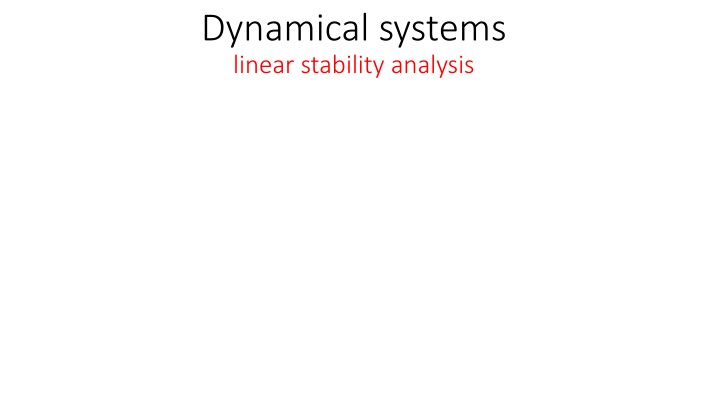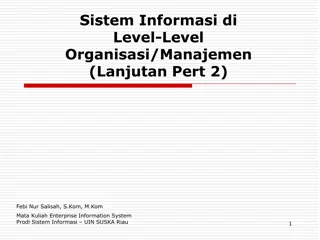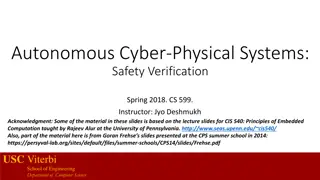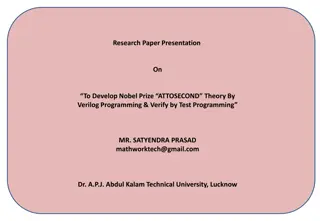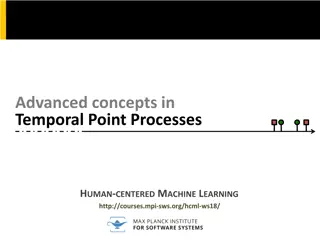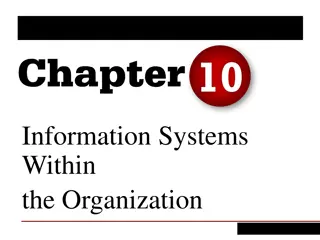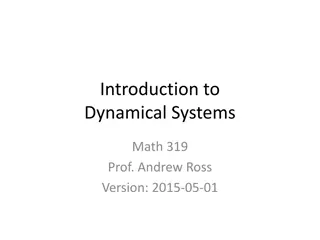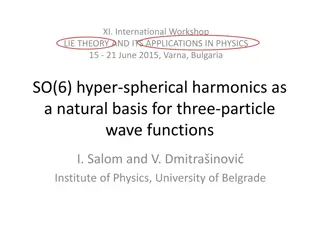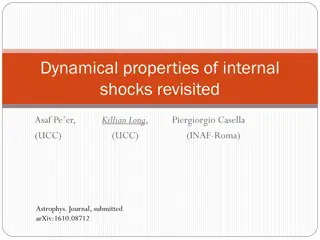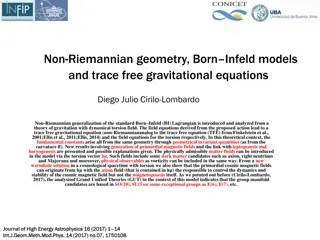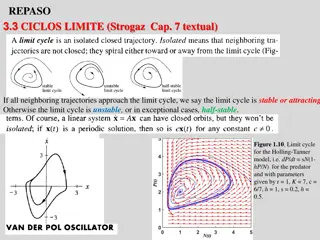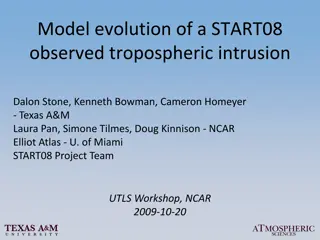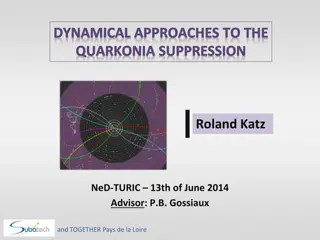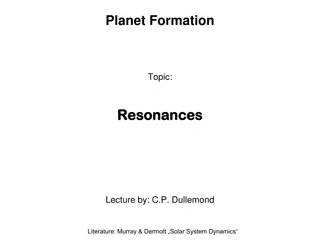Dynamical systems
A fundamental aspect in the study of dynamical systems is the analysis of linear stability, which provides insights into the system's behavior around equilibrium points. By examining the system's characteristics through linear stability analysis, researchers can determine the stability of these points and make predictions about the system's long-term behavior. Understanding this concept is crucial for various fields such as physics, engineering, and biology, where complex systems are prevalent. Through rigorous mathematical techniques and computations, linear stability analysis offers a systematic approach to investigating the dynamic properties of a wide range of systems.
Download Presentation

Please find below an Image/Link to download the presentation.
The content on the website is provided AS IS for your information and personal use only. It may not be sold, licensed, or shared on other websites without obtaining consent from the author.If you encounter any issues during the download, it is possible that the publisher has removed the file from their server.
You are allowed to download the files provided on this website for personal or commercial use, subject to the condition that they are used lawfully. All files are the property of their respective owners.
The content on the website is provided AS IS for your information and personal use only. It may not be sold, licensed, or shared on other websites without obtaining consent from the author.
E N D
Presentation Transcript
Dynamical systems linear stability analysis
Introduction Main questions in science? System behavior at t , i.e., describing quantities characterizing the system (ii) Stability analysis System: Equilibrium point Steady state (ss) (i) Ordinary differential equations (ODEs), partial differential equations (PDEs) ?? ??= ? ? , = constant d /dt = 0 ? ? = 0 = ?0 Two steady states: = 0 = Stable ss Unstable ss z Perturbation of the steady states time
Chemical kinetics Chemical reaction Chemical reaction ? ? + ? + ? + ? + A, B, chemical species , , , stoichiometric coefficient k reaction rate constant mass action kinetics v = ? A B v is the reaction rate d[A dt A = v = k A B = 1 i dt = r d A = ( ) iv r is the number of chemical reactions
Examples reaction mechanism d? d?= 2v1+v2 2A + B C 2C D + A D 2B v1=k1ab v2=k2c2 v3=k3d d? d?= v1+2v3 d? d?= v1 2v2 1 d? d?= v2 v3 2
Set of linear differential equations 1D dx/dt = kx, x(t = 0) = x0 Steady state: if dx/dt = 0 kx = 0 xss= 0 Solution: x(t) = x0 ekt Steady state at x = 0, if k < 0 stable ss; x(t) 0, i.e., goes to the ss if k 0 unstable ss; x(t) if t , ekt
Set of linear differential equations 2D x = Ax x1 = a11x1 + a12x2 x2 = a21x1 + a22x2 x = x1 , A = a11 a12 a22, x (t = 0) = x0 x2 a21 (ii) Solution? (i) What is the steady state? ?(?) = ?????? x = 0 Ax = 0 0 = a11x1 + a12x2 0 = a21x1 + a22x2 eigenvector Eigenvalue of A xss= 0
Set of linear differential equations 2D x = Ax x1 = a11x1 + a12x2 x2 = a21x1 + a22x2 Eigenvalue of A x = x1 , A = a11 a12 a22, x (t = 0) = x0 det(A E) = 0 x2 a21 A = a11 a12 a22 (ii) Solution? (i) What is the steady state? a21 ?(?) = ?????? x = 0 Ax = 0 det a11 ?1 a12 = 0 0 = a11x1 + a12x2 0 = a21x1 + a22x2 a21 a22 ?2 eigenvector eigenvalues of A 2 (a11+a22) + (a11a22 a12a21) = 0 xss= 0
Set of linear differential equations 2D t (ii) Solution? (i) What is the steady state? if > 0 then e t ( t ) UNSTABLE ?(?) = ?????? x = 0 Ax = 0 0 = a11x1 + a12x2 0 = a21x1 + a22x2 eigenvector eigenvalues of A if < 0 then e t 0 ( t - ) STABLE xss= 0
Set of linear differential equations 2D - solutions 1 > 0, 2 > 0, both are real unstable node 1 < 0, 2 < 0, both are real stable node 1 > 0, 2 < 0 or 1 < 0, 2 > 0 and both are real saddle = Re( ) Im( )and Re( ) < 0 stable focus = Re( ) Im( )and Re( ) = 0 center = Re( ) Im( )and Re( ) > 0 unstable focus
Phase Phase portrait portrait
Set of non-linear differential equations Linear stability analysis 2D x = f(x) (ii) Solution? NO analytical solution numerical solution (i) What is the steady state? x = 0 f(xss) = 0 x = xss + perturbation (small) d(xss + )/dt = f (xss + ) dxss/dt+ d /dt = f (xss + ) d /dt = f (xss + ) By definition dxss/dt= 0 Taylor expansion
Set of non-linear differential equations Linear stability analysis 2D d2? d2x( xss) 2+ ?f ?x( xss) +1 x = xss + f(xss+ ) =f(xss) + 2 d(xss + )/dt = f (xss + ) ?f ?x( xss) dxss/dt+ d /dt = f (xss + ) f (xss+ ) =f(xss) + d /dt = f (xss + ) ?f ?x( xss) f (xss) = 0 f (xss+ ) = ?x( xss) d /dt = ?f Linear differential equation for the perturbation x = Ax
Set of non-linear differential equations Linear stability analysis 2D ?x( xss) d /dt =?f Linear differential equation for the perturbation x = Ax = J J is the Jacobian matrix f x g x f y g y ?= ? ?= ? J = ? ?
Problem ?1 (i) Find the steady states of the system 2 A + X 2 X ?2 X + 2 Y ?3 3 Y (ii) Calculate the Jabobian matrix and calculate the eigenvalues Y (iii) Characterize the steady states a, x, y are the concentrations, a = 1, k1 = k2 = k3 = 1 (iv) Check your solution with the PhasePictor software (i) Determination of the reaction rates 2 A + X 2 X X + 2 Y 3 Y ?1 v1=a2x v2=xy2 ?2 ?3 Y v3=y
Problem (i) Determination of the reaction rates 2 A + X 2 X X + 2 Y 3 Y (i) Find the steady states of the system ?1 v1=a2x v2=xy2 (ii) Calculate the Jabobian matrix and calculate the eigenvalues ?2 (iii) Characterize the steady states ?3 Y v3=y (iv) Check your solution with the PhasePictor software (ii) Determination of rate of concentrations (2 variable system) ?? ??= ?2? + 2?2? ??2 ?? ??= 2??2+ 3??2 ? ?? ??= ?2? ??2 ?? ??= ??2 ? ?? ??= ? ??2 ?? ??= ??2 ?
Problem (ii) Determination of rate of concentrations (2 variable system) ?? ??= ? ??2 ?? ??= ??2 ? (i) Find the steady states of the system (ii) Calculate the Jabobian matrix and calculate the eigenvalues (iii) Characterize the steady states (iv) Check your solution with the PhasePictor software (iii) Determination of steady states ?? ??= ? ??2,? ?,? = ? ??2 ?? ??= ??2 ?,? ?,? = ??2 ? ?? ??= 0 ?? ??= 0 2= 0 ? ?ss,?ss = 0,?ss ?ss?ss ? ?ss,?ss = 0,?ss?ss 2 ?ss= 0 ?ss= 0,?ss= 0 ?ss= 1,?ss= 1 ?ss= 1,?ss= 1
Problem (iii) Determination of steady states ?? ??= ? ??2,? ?,? = ? ??2 ?? ??= ??2 ?,? ?,? = ??2 ? ?ss= 0,?ss= 0 ?ss= 1,?ss= 1 ?ss= 1,?ss= 1 (iv) Calculation of Jacobian matrix f x g x f y g y 1 ?2 ?2 2?? 2?? 1 J = = (v) Characterization of steady states 1 0 0 det1 ? 0 (1 )( 1 ) 0 = 0 = 0 ? ?ss= 0,?ss= 0 1 0 1 ? Jacobian eigenvalues
Problem f y g y ?ss= 0,?ss= 0 ?ss= 1,?ss= 1 ?ss= 1,?ss= 1 f x g x 1 ?2 ?2 2?? 2?? 1 J = = (v) Characterization of steady states 1 0 0 det1 ? 0 (1 )( 1 ) 0 = 0 = 0 ? ?ss= 0,?ss= 0 1 0 1 ? Jacobian eigenvalues 1= 1, 2 = 1 saddle
Problem f y g y ?ss= 0,?ss= 0 ?ss= 1,?ss= 1 ?ss= 1,?ss= 1 f x g x 1 ?2 ?2 2?? 2?? 1 J = = (v) Characterization of steady states 0 1 2 1 det ? 2 1 ? ( )(1 ) +2 = 0 2 + 2 = 0 = 0 ? ?ss= 1,?ss= 1 1 Jacobian eigenvalues ? =1 7 2 2? ? ?ss= 1,?ss= 1 unstable focus
